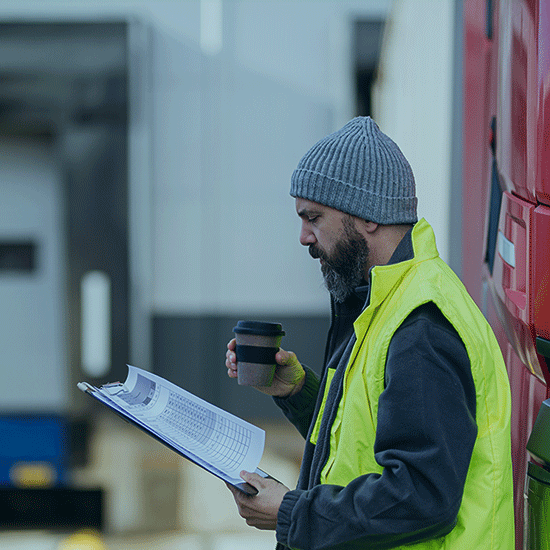CDL pre-trip inspections are a daily requirement, but for many fleets, they can become one of the operation’s most inconsistent and overlooked aspects. Whether due to time constraints, lack of oversight, or outdated paper-based systems, skipped or incomplete inspections create serious exposure—especially during roadside checks.
To help your team stay ahead, this guide breaks down the inspection categories necessary for FMCSA compliance and vehicle safety. We’ve also included a downloadable 2025 checklist that drivers can use as a quick reference during their walkarounds. Thorough and consistent inspections help catch small issues before they become big problems—and keep your fleet running without interruption.
What is a CDL Pre-Trip Inspection and Why Does It Matter?
A CDL pre-trip inspection is a federally required process to confirm that a commercial vehicle is safe to operate. According to FMCSA Part 396, drivers must inspect key systems—brakes, tires, lights, steering, and more—before every shift. The results are documented in a Driver Vehicle Inspection Report (DVIR), which must be accurate and complete to stay compliant.
But this isn’t just a driver task—it’s a fleet-wide responsibility with real operational consequences if not completed correctly. Consistent pre-trip inspections help you:
- Avoid violations and out-of-service orders: Incomplete or skipped inspections can result citations or delays during roadside checks.
- Prevent safety incidents: Identifying defects early reduces the risk of accidents caused by avoidable mechanical failures.
- Protect your CSA score: FMCSA tracks safety and compliance violations—bad scores affect your public records and your ability to win contracts.
- Minimize repair costs and downtime: Catching issues before vehicles leave the yard and staying on top of fleet maintenance is cheaper than emergency fixes or breakdowns en route.
When inspections are rushed or skipped, everyone loses—your drivers, your customers, and your profits.
Components of a CDL Pre-Trip Inspection Checklist
A pre-trip inspection covers every critical system that could affect safety, performance, or compliance. Below are the main areas drivers should examine and document before every shift to meet FMCSA regulations.
Engine Compartment
Drivers should start with the hood open to check fluid levels, visible components, and potential leaks. Look for:
- Oil level using the dipstick to ensure it’s within the safe range
- Coolant level in the reservoir, with no visible leaks or cracks
- Power steering fluid, checking both level and condition
- Belts and hoses, watching for cracks, fraying, or loose fittings
- Battery cables and terminals—make sure they’re secure, free of corrosion, and not leaking
Any signs of leakage or wear here could indicate a maintenance issue that needs attention before going out on the road and should be addressed asap.
Vehicle Exterior
Next, drivers should inspect the vehicle’s outer components, lighting, and glass for visibility and safety issues. This includes:
- Headlights, brake lights, turn signals, and reflectors, confirming they’re working properly and not cracked or obstructed
- Tires, ensuring proper inflation, tread depth (at least 4/32” on steer tires), with no cuts or bulging
- Rims and wheels, checking for damage, missing lugs, or signs of looseness
- Windshield and side mirrors, confirming they’re clean, intact, and properly mounted
- Windshield wipers, ensuring rubber blades are in good condition and fluid sprays correctly
Skipping over exterior checks may seem minor, but it’s one of the fastest ways to rack up preventable violations or get flagged during a roadside inspection.
Brake System
The braking system should be checked thoroughly, especially on air brake-equipped vehicles. Drivers should:
- Inspect brake hoses and lines for cracks, leaks, or improper connections
- Check slack adjusters and pushrods—with brakes released, there should be no more than one inch of movement
- Look at brake pads and drums, ensuring there’s adequate thickness and no glazing or cracking
- Perform an air leakage rate check, watching for excessive air loss when the brakes are applied
Brake-related violations are among the most common during roadside inspections, so drivers should be encouraged to take their time for a thorough examination before they hit the road.
Steering and Suspension
Faults in steering or suspension components can lead to poor handling and dangerous driving issues. Drivers need to check:
- Steering gear and linkage, ensuring all joints are tight, lubricated, and free of excessive play
- Power steering fluid for proper level and leaks
- Springs and spring hangers, looking for cracks or missing pieces
- Shock absorbers, confirming they’re securely mounted and free of leaks
- Mounts and bushings, checking for excessive wear or damage
A quick tug test or visual inspection of each component helps spot issues early.
Cab and Safety Equipment
Inside the cab, drivers must verify that safety systems and emergency equipment are fully functional. This includes:
- Horn, both electric and air-operated
- Seat belts, confirming they latch properly and are free of frays
- Heater and defroster, especially in colder months
- Windshield washer system, including fluid level and spray function
- Fire extinguisher, ensuring it’s charged and accessible
- Emergency triangles and spare fuses, which must be present and properly stored
FMCSA regulations require certain safety items to be in the vehicle at all times, so missing equipment is a quick route to a citation.
Trailer (If Equipped)
For drivers hauling trailers, a full inspection must include:
- Trailer brake connections, verifying secure attachment and no air leaks
- Electrical connections, ensuring the trailer’s lights and signals are working correctly
- Lights and reflectors, checking for visibility and function
- Landing gear, making sure it raises and lowers smoothly
- Tandem axle release and locking pins, verifying proper engagement
Trailer inspections help prevent dangerous disconnections, lighting failures, or issues during coupling and uncoupling at the dock.
Common Inspection Mistakes and How to Avoid Them
Inspections are a routine part of the job, so it can be easy for drivers to cut corners—even if they don’t mean to. Maybe they skip part of the walkaround. Maybe they assume the last driver already flagged any issues. Or they forget to log something that seemed minor at the time.
These slip-ups might not seem like a big deal, but they’re exactly what leads to roadside violations and out-of-service orders. And without proper documentation, you’ve got no way to prove that inspections are being done right—or done at all.
The right technology allows you to tighten the process without adding more to your drivers’ plates. With digital checklists and mobile reporting, you can track what’s been done, catch what hasn’t, and hold the whole team accountable.
How Digital Tools Help Fleets Simplify Inspections
Paper forms leave too much room for error. They get lost, filled out incorrectly, or ignored altogether—and there’s no easy way to verify what was actually completed. Digital inspection tools solve that by giving drivers a step-by-step guide that’s consistent and easy to track.
With mobile DVIRs and real-time syncing, inspection data is logged instantly and shared across your team. You can quickly see which inspections are complete, what issues were flagged, and whether they’ve been resolved—without waiting for drivers to call in issues or paperwork to come back to the office.
Digital platforms also help standardize the process across your fleet. Whether you manage five drivers or fifty, everyone follows the same checklist, submits the same reports, and uses the same system. That consistency prevents small problems from becoming big ones.
Safer Fleets Start with Smarter Tools from Solera
Pre-trip inspections are your first line of defense—but they only work when you can see what’s actually being done. Solera brings that visibility to life. With customizable digital DVIRs, fleets can guide drivers through every required inspection step and ensure reports are submitted in real time. No skipped fields, no missing signatures.
But the inspection doesn’t stop at submission. Solera’s maintenance management platform connects inspection results to service workflows, so defects flagged in the field are logged instantly and tracked through to repair. Everything’s documented, auditable, and visible across your team—from drivers to technicians to compliance managers.Download the 2025 CDL Pre-Trip Inspection Checklist to help your drivers stay consistent. And contact Solera Fleet Solutions to see how our platform can support safer, smarter, and more efficient fleet operations.




